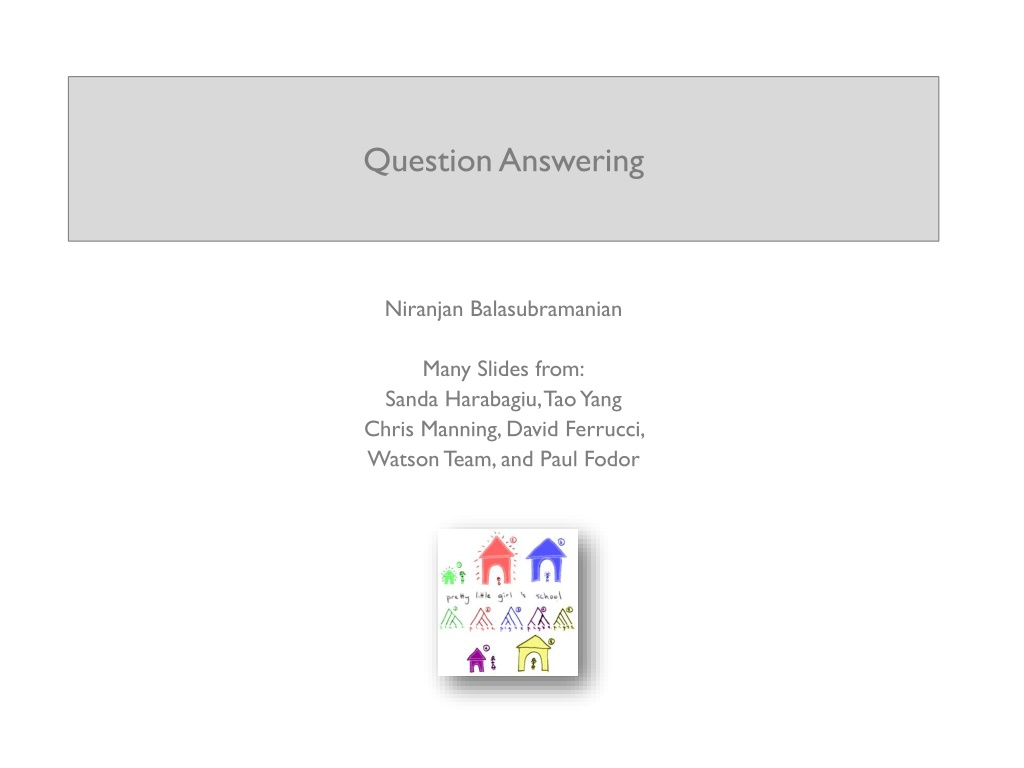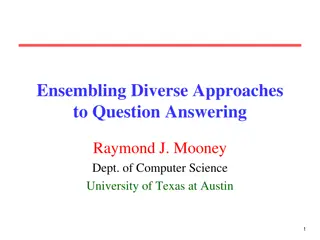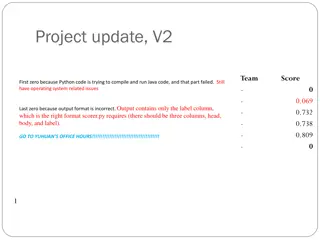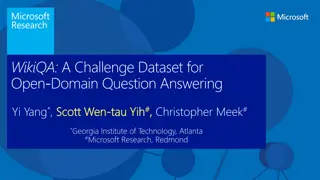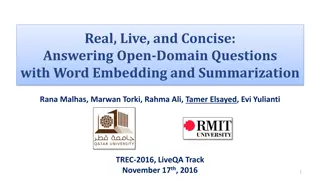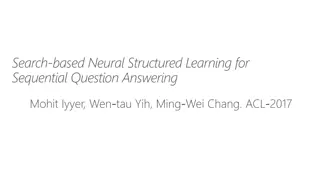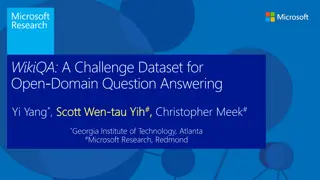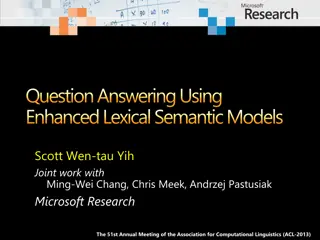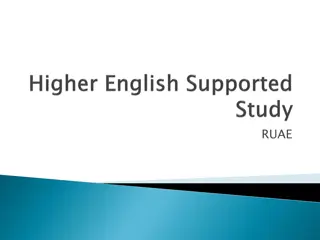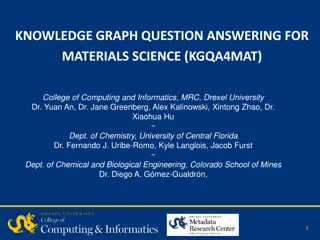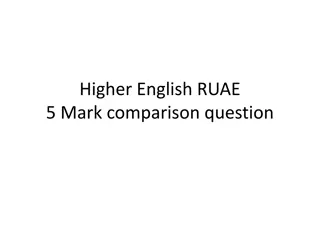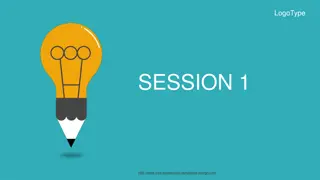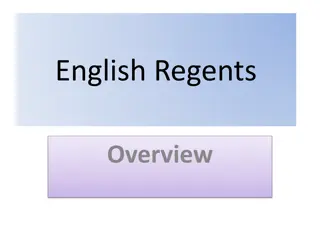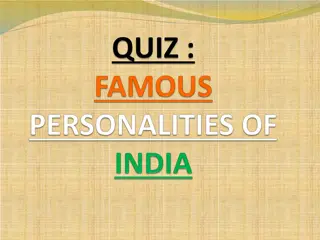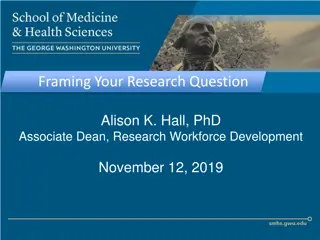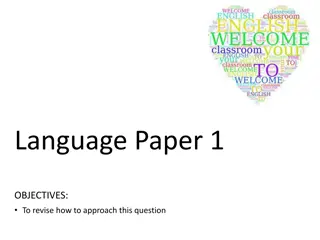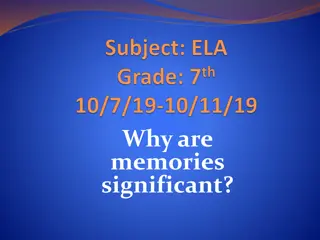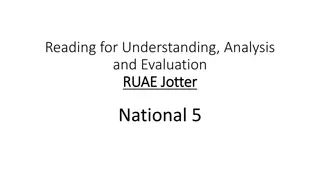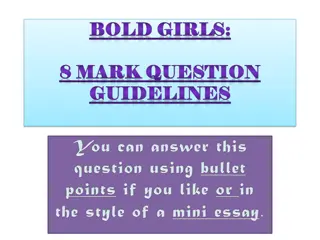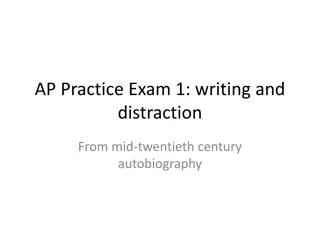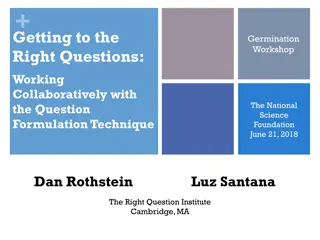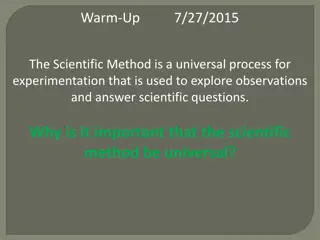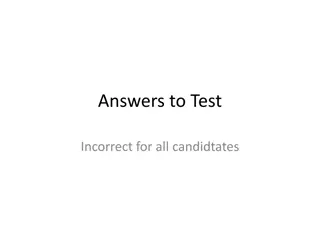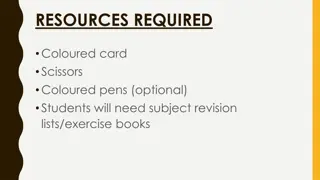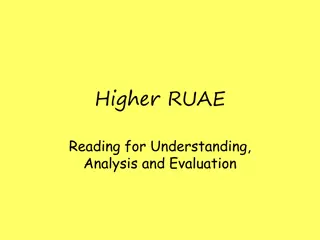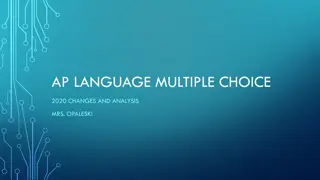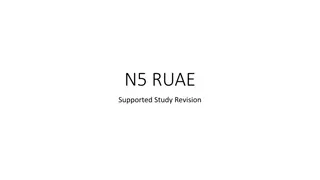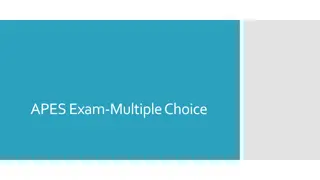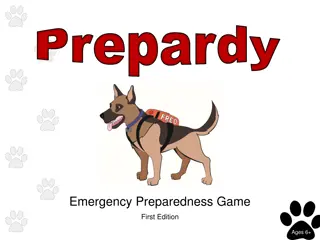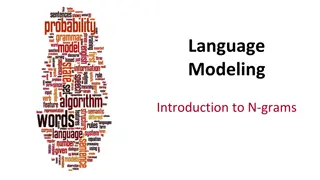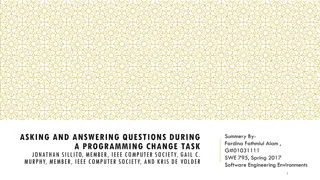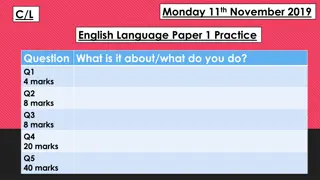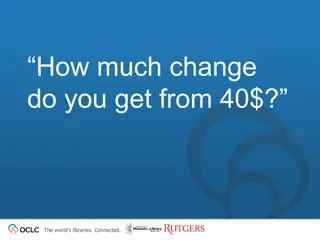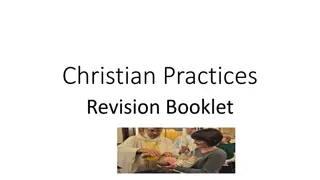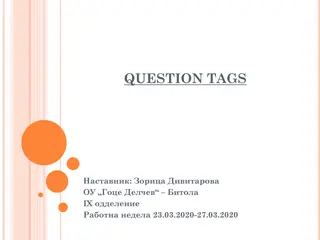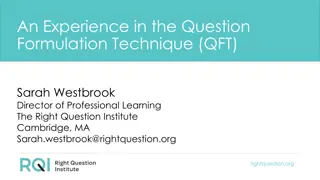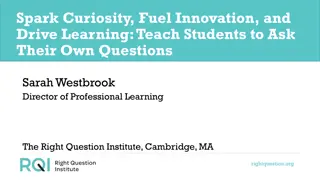Exploring Question Answering Techniques in AI
Delve into the intriguing world of question answering with insights on various types of QA tasks and approaches like reading-based QA, reasoning-focused systems, and graph-based reasoning. Understand the relevance of QA in today's mobile world, its utility as a benchmark for AI, and its application in different domains. Discover how computers can answer questions through pre-constructed knowledge, on-demand reading, and reasoning methods.
Download Presentation

Please find below an Image/Link to download the presentation.
The content on the website is provided AS IS for your information and personal use only. It may not be sold, licensed, or shared on other websites without obtaining consent from the author. Download presentation by click this link. If you encounter any issues during the download, it is possible that the publisher has removed the file from their server.
E N D
Presentation Transcript
Question Answering Niranjan Balasubramanian Many Slides from: Sanda Harabagiu, Tao Yang Chris Manning, David Ferrucci, Watson Team, and Paul Fodor
Outline Question Answering Types of QA tasks and approaches Reading-based QA A General Architecture Systems AskMSR FALCON Watson QA over Structured Databases Semantic parsing Reasoning focused Systems Graph-based reasoning Probabilistic + Logical Reasoning
Why is question answering interesting? Often we are interested in just answers and not documents. Who won the 2015 Super Bowl? How tall is Taylor Swift? Is Tom Hanks married? What are two states that share a border with New York? Concise answers can be useful for todays mobile world. Useful benchmark for AI Can be used as a test of knowledge and understanding.
Types of Question Answering Tasks Text-based Question Answering Closed corpus Open-domain and Web-based Community-based Reading comprehension (MC-SAT from MSR) Standardized Exams (4thGrade Science Exams from AI2) Question Answering Over Structured Databases Specialized domains (e.g., Geographic Databases) Large-scale open-domain (e.g., Freebase)
How can we get computers to answer questions? Pre-constructed Knowledge On-demand reading Reasoning
Reading-based QA from unstructured texts Question Text Search + Scoring Answers
QA over Structured Data Question Text Relational Query Relational Query Engine Answers Who discovered DNA SELECT * from discoveries where discovery= DNA
Reasoning-based QA Logical Form Question Text Logical Reasoning Answers Logical Forms Does an iron nail conduct electricity? metallic objects conduct electricity iron nail is made of iron => iron nail is a metallic object metallic objects conduct electricity ^ iron nail is a metallic object => iron nail conducts electricity.
Reading-based QA Approaches Key Idea Look up text that is likely to contain the answer and locate the answer. Key Challenges Finding which text bits are likely to contain the answer. Finding the answer given a piece of text. Benefits Doesn t rely on any particular format for knowledge. Can use any text-based source. Much of our knowledge is in textual form still. Disadvantages Large textual sources can be problematic because of spurious matches. Need scalable solutions.
Reading-based QA: Architecture Question Answers Question Processing Answer Extraction Answer Scoring Search Question Templates Taxonomic Resources Corpus Resources
Question Processing What is the tallest mountain in the world? Question Processing Question Type: Answer Type: Keywords: WHAT MOUNTAIN tallest, mountain, world
Question Type Identification Knowing question type helps in many ways. -- Provides a way to filter out many candidates. -- Often type specific matching and handling are implemented. Class 1 Answer: single datum or list of items C: who, when, where, how (old, much, large) A: multi-sentence C: extract from multiple sentences A: across several texts C: comparative/contrastive A: an analysis of retrieved information C: synthesized coherently from several retrieved fragments Class 2 Class 3 Class 4 Class 5 A: result of reasoning C: word/domain knowledge and common sense reasoning
Question Type Identification Hand-generated patterns When => Date/Time type question Where => Location type question Supervised Classification
Search Question Type: Answer Type: Keywords: WHAT MOUNTAIN tallest, mountain, world Search Corpus
Search Key benefit is to limit the amount of passages/sentences to search. Deeper matching approaches are often much slower. Typical approach is to use keywords-based query. Remove stop words, perform stemming etc. Different from document retrieval Passages are often short (same smoothing techniques don t work well). Lexical variability is especially thorny when dealing with short passages. Often passages are filtered or scored lower for not matching the answer type.
Answer Extraction Question Type: Answer Type: Keywords: WHAT MOUNTAIN tallest, mountain, world Answer Extraction [Mount Everest] is called the world's highest mountain because it has the highest elevation above sea level. [Mauna Kea] is over 10,000 meters tall compared to 8,848 meters for Mount Everest - making it the "world's tallest mountain". However, [Chimborazo] has the distinction of being the ""highest mountain above Earth's center".
Answer Extraction Question type and Answer type guide extraction. Where questions candidates are typically locations. You can learn the question type to answer type mapping from data. A standard back-off is to consider all noun phrases in the passage or sentence. With additional pruning tricks (e.g., remove pronouns). Sequence labeling problem i.e., predict a sequence of ANSWER labels in sentences. Over generation is the norm. Don t want to miss answers. We ve already pruned the search space to a small set of passages.
Answer Scoring [Mount Everest] is called the world's highest mountain because it has the highest elevation above sea level. [Mauna Kea] is over 10,000 meters tall compared to 8,848 meters for Mount Everest - making it the "world's tallest mountain". However, [Chimborazo] has the distinction of being the highest mountain above Earth's center". Question Type: Answer Type: Keywords: WHAT MOUNTAIN tallest, mountain, world Answer Scoring 0.9 Mauna Kea 0.5 Mount Everest 0.3 Chimborazo
Answer Scoring Most critical component of most QA systems. Frequency based solutions when using large scale collections such as web. State-of-the-art is to use supervised learning over many features. BOW similarity between question and context around answer. Syntactic similarity Semantic similarity Graph-matching Learning to Rank approach used by Watson. Next class.
AskMSR: A Shallow QA Approach Use the web! Extracting answers from a single document is difficult. Language in document may be quite different from the question. Web contains the same information repeated in many different ways. Higher chance that the question language might match some document. If the same answer is extracted from multiple documents, then it is likely correct.
AskMSR: System Architecture Search Question Processing 1 2 3 5 4 Answer Scoring Answer Extraction
AskMSR: Question Processing Intuition Questions and answers are quite close to each other in syntactic constructions. Questions can be transformed into answer extraction patterns. Q: Where is the Louvre Museum located? A: The Louvre Museum is located in Paris A: The Louvre Museum located in Paris is one of the best. Q: Where is the Louvre Museum located? A: Louvre Museum is located .. [ANSWER] A: The location of the Louvre Museum located is [ANSWER]
Question Processing: Rewrite Patterns Question Question: 1) Move the verb through each position in the question. Q v w1 w2 ? Where is the Louvre located? 2) Add a back-off query that is simply an AND of all non stop word terms. To cover patterns that include non-question words. Rewrite Patterns Rewrite Patterns: [ vw1 w2 w3 , L] [ w1 vw2 w3 , R] [ w1 w2 vw3 , R] [vw1 w2 w3 , E] [ is the Louvre Museum located , L] [ the is Louvre Museum located , R] [ the Louvre is Museum located , R] [ the Louvre Museum is located, E] 3) Specify where the answer is located. Heuristic left/right/either. Some of these patterns are nonsensical. Don t care as long as no bad answers are produced!
Question Processing: Rewrite Patterns Question: Where is the Louvre located? Rewrite Patterns: [ is the Louvre Museum located , L] [ the is Louvre Museum located , R] [ the Louvre is Museum located , R] [ the Louvre Museum is located, E] Not all patterns are equal: High precision low coverage. Low precision high coverage. Can weight patterns!
AskMSR: Search Send all rewrites to a Web search engine Retrieve top N answers (say 100) For speed, rely just on search engine s snippets Not the full text of the actual document.
AskMSR: Answer Extraction Intuition Factoid answers are likely to be short phrases. Mine N-Grams and filter it to fit the expected answer types.
Answer Extraction: Mining N-Grams Simple: Enumerate N-grams (N=1,2,3 say) in all retrieved snippets Use hash table and other fancy footwork to make this efficient Weight of an n-gram: occurrence count, each weighted by reliability (weight) of rewrite that fetched the document Who created the character of Scrooge? Dickens - 117 Christmas Carol - 78 Charles Dickens - 75 Disney - 72 Carl Banks - 54 A Christmas - 41 Christmas Carol - 45 Uncle - 31
Answer Extraction: Filtering N-Grams Use data-type filters = regular expressions to remove answers that don t meet expected answer types. When [Date] Where [Location] What [Date, Location] Who [Person] Boost score of n-grams that do match data types. Lower score of n-grams that don t match data types. Who created the character of Scrooge? Dickens 117 * 5 Charles Dickens 75 * 5 Disney 72 * 5 Carl Banks 54 * 5 Uncle 31 * 5 A Christmas 41 * 2 Christmas Carol 45 * 2
Answer Variability Issue Answer maybe in expressed in different ways. Counts get distributed. Who created the character of Scrooge? Dickens 117 * 5 Charles Dickens 75 * 5 Disney 72 * 5 Carl Banks 54 * 5 Uncle 31 * 5 Mr. Dickens 10 * 5 Mr. Charles Dickens 5 * 5 A Christmas 41 * 2 Christmas Carol 45 * 2 Solution: Tiling Merge sequences A B and B C to form A B C with aggregated count.
Answer Scoring: Tiling the Answers Scores 20 Charles Dickens merged, discard Dickens 15 old n-grams Mr Charles 10 Score 45 Mr Charles Dickens tile highest-scoring n-gram N-Grams N-Grams Repeat, until no more overlap
TREC QA Dataset 900 fact-based questions, A bit over million documents consisting of news articles. 1. Who is the author of the book, "The Iron Lady: A Biography of Margaret Thatcher"? 2. What was the monetary value of the Nobel Peace Prize in 1989? 3. What does the Peugeot company manufacture? 4. How much did Mercury spend on advertising in 1993? 5. What is the name of the managing director of Apricot Computer? 6. Why did David Koresh ask the FBI for a word processor? 7. What is the name of the rare neurological disease with symptoms such as: involuntary movements (tics), swearing, and incoherent vocalizations (grunts, shouts, etc.)?
Evaluation Measures Mean Reciprocal Rank (MRR) scoring with ranked answers: 1, 0.5, 0.33, 0.25, 0.2, 0 for 1, 2, 3, 4, 5, 6+ doc Precision/Recall/F1 with Single exact answer Discrepancies Gold answers can be incomplete. System provided answers can be lexically different from gold answers. e.g., Mt. Everest, Mount Everest, Everest
Results Technique doesn t do too well (in top 9 of ~30 participants!) MRR = 0.262 (ie, right answered ranked about #4-#5) Using the Web as a whole, not just TREC s 1M documents MRR = 0.42 (ie, on average, right answer is ranked about #2-#3) Why? Because it relies on the enormity of the Web! Weighting snippets leads to further improvements: +0.02 in MRR.
Pipelined Architecture Issue Issues: Errors in each box propagate and compound. Decisions made once aren t corrected if new evidence is available. Idea: Include feedback loops and re-do processing in earlier stages. Question Answers Question Processing Answer Extraction Search Answer Scoring Question Templates Taxonomic Resources Corpus
Feedback Loops: FALCON Loop 1: Do I have good keywords to represent the question? Test: No: If many passages are retrieved or if too few passages are retrieved. Yes: Otherwise. Action: Make query less or more specific depending on the failure mode.
Feedback Loops: FALCON Loop 2: Do I have answer candidates that are likely to contain the answer? Test: No: If dependency structure of question and candidates don t match. Yes: Otherwise. Action: Add morphological alternations. e.g., Who invented + inventor Add lexical alternations (synonyms). e.g., How far is + distance
What is Jeopardy? EACH YEAR IT'S BLACK HISTORY MONTH $200 Months of Year SLUMDOG MILLIONAIRE IS SET IN THIS INDIAN CITY $500 Recent Movies IT'S THE THIRD-LARGEST STATE IN THE U.S. IN AREA $300 US States Each question comes with an assignment of points. Whoever presses the buzzer first gets to answer. Correct answer adds points, while incorrect or no answer results in a deduction.
What kind of precision/recall trade-off is needed? Best TREC-based QA system (2007) weren t good enough.
Watsons Approach Approach Generate several possible candidate answers (hypothesis). Go back and find evidence supporting each candidate answer. Use machine learning to combine evidence. Key Design Decisions Automatically generate knowledge. Runtime answer type coercion. Massively parallel architecture. Tune nearly every component with machine learning.
How Watson Processes a Question IN 1698, THIS COMET DISCOVERER TOOK A SHIP CALLED THE PARAMOUR PINK ON THE FIRST PURELY SCIENTIFIC SEA VOYAGE Related Content (Structured & Unstructured) Keywords: 1698, comet, paramour, pink, AnswerType(comet discoverer) Date(1698) Took(discoverer, ship) Called(ship, Paramour Pink) Primary Search Question Analysis Candidate Answer Generation [0.58 0 -1.3 0.97] Isaac Newton [0.71 1 13.4 0.72] Wilhelm Tempel [0.12 0 2.0 0.40] HMS Paramour 1) 2) 3) Edmond Halley (0.85) Christiaan Huygens (0.20) Peter Sellers (0.05) [0.84 1 10.6 0.21] Christiaan Huygens [0.33 0 6.3 0.83] Halley s Comet [0.21 1 11.1 0.92] Edmond Halley Merging & Ranking [0.91 0 -8.2 0.61] Pink Panther [0.91 0 -1.7 0.60] Peter Sellers Evidence Retrieval 43 Evidence Scoring 43
Watsons Architecture: An Empirical Researchers Nightmare! Learned Models help combine and weigh the Evidence Evidence Sources Models Models Answer Sources Question Evidence Retrieval Evidence Scoring Models Models Candidate Answer Generation Primary Search Models Models Synthesis Answer & Confidence Hypothesis and Evidence Scoring Merging & Ranking . . .
Question Decomposition Parallel Decomposable Questions This company with origins dating back to 1876 became the first U.S. company to have 1 million stockholders in 1951. Q1 This company with origins dating back to 1876 Q2 The first U.S. company to have 1 million stockholders in 1951 Nested Decomposable Questions (Inner/Outer evaluation) A controversial 1979 war film was based on a 1902 work by this author (Q1 (Q2 A controversial 1979 war film) was based on a 1902 )
Watsons Architecture: An Empirical Researchers Nightmare! Learned Models help combine and weigh the Evidence Evidence Sources Models Models Answer Sources Question Evidence Retrieval Evidence Scoring Models Models Candidate Answer Generation Primary Search Models Models Synthesis Answer & Confidence Hypothesis and Evidence Scoring Merging & Ranking . . .
Candidate Search Clue Output: Candidate Passages + Candidate Relations Unstructured [Encyclopedia] [News Wire] DBPedia PRISMATIC
Candidate Generation Type restricted candidate generation systems were too restrictive. Even as many 200 types were found to be restrictive. Instead try generating candidates first and then use type coercion to score. Candidates from Unstructured Sources: Candidates from Structured Sources: Title of document Title of documents that best match the facts mentioned in the clue. Retain provenance information (i.e., the document). e.g., Who killed Lincoln? Query Relations: (_, killed, Lincoln), (_, assassinated, Lincoln) Answer candidates: (Booth, killed, Lincoln) (Booth, assassinated, Lincoln) The non-query portion of the relation is the candidate. Wikipedia Title Candidate 95% of the answers were Wikipedia titles. Identify words/phrases that are Wikipedia page titles but not subsumed. Anchor Text Candidates Metadata of the Wikipedia pages from which the passage was retrieved. Anchor texts in the passage.
Candidate Generation Evaluation Most failures due to extraneous terms that are not relevant to finding the answer.
Watsons Architecture: An Empirical Researchers Nightmare! Learned Models help combine and weigh the Evidence Evidence Sources Models Models Answer Sources Question Evidence Retrieval Evidence Scoring Models Models Candidate Answer Generation Primary Search Models Models Synthesis Answer & Confidence Hypothesis and Evidence Scoring Merging & Ranking . . .
